When you travel to Italy for the first time, you’re not surprised by the expansive blue sky, the incredible art, the amazing food or the conviviality of the Italians. All of these things are already in our romanticized vision of Italy before we get on the plane. One thing many people are surprised about their first morning in Italy, however, is breakfast.
What is a Traditional Italian Breakfast?
Tourists are often confused by the light fare and the striking absence of anything savory when they venture out for their morning meal. You won’t find eggs, bacon, sausage, or even slices of meat and cheese. La colazione, or Italian breakfast is sweet and they don’t traditionally eat savory or heavy foods for breakfast.
On the way to work or on a weekend morning, Italians might have breakfast at il bar. But it’s more like a cafe. Bars serve coffee and pastries in the morning and later in the day they’ll serve drinks and snacks for an aperativo. Breakfast is often taken standing at the bar and normally features an espresso or cappuccino. Milk-based coffee drinks are usually only consumed in the morning, and later in the day they’ll switch to just espresso. Along with their coffee they might have a cornetto (an Italian croissant), or other pastry like a crostata.
At home, coffee is normally made in a moka pot, and served with milk for a caffelatte. There might be an assortment of biscotti, like Gocciole, Abbracci, Macine or Gentilini Novellini to have with their coffee. They also love fette biscottate, which is a rusk that they spread with jam. You might even have cake for breakfast.
Italian breakfast might be short and sweet, but trust me, once you make it to lunch, you’ll be glad it was.
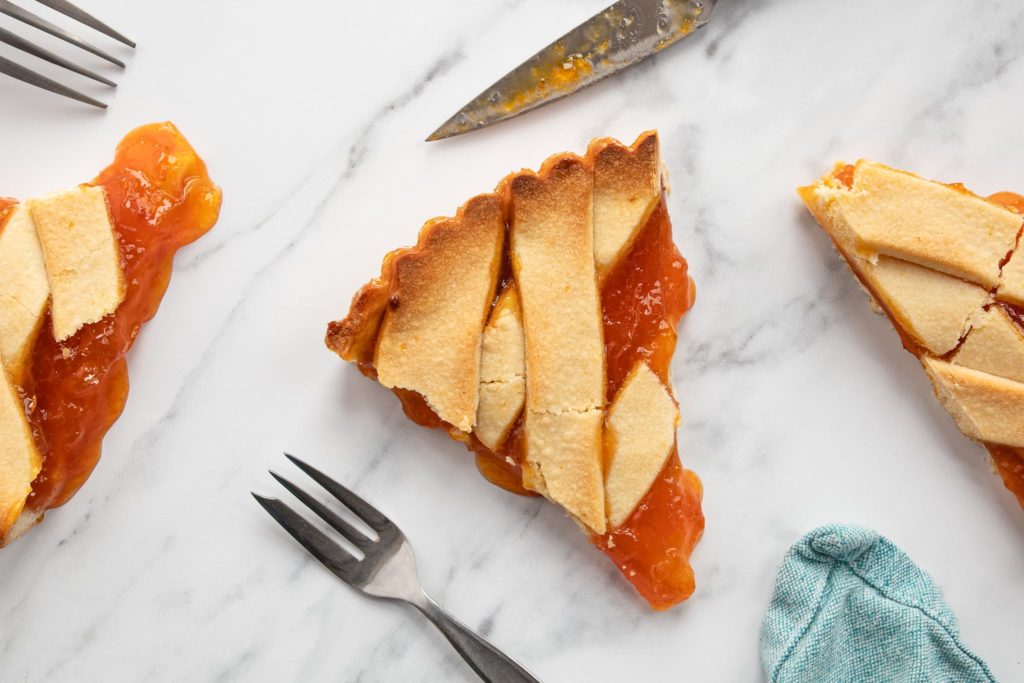
Crostata alla Marmellata
Whether you plan to have it for breakfast, dessert, or as an afternoon snack with coffee, crostata is rustic bliss. Crostata is a classic pastry that can be found throughout all of Italy. It’s made with rich and crumbly pasta frolla flavored with zest, filled with jam, and topped with a delightfully imperfect lattice.
Pasta frolla is Italy’s version of pâte sucrée. It is more cookie-like than pâte sucrée, and in a crostata it’s rolled out thicker than in delicate French tartelettes. It’s traditionally made with a 2:1 flour to butter ratio. Cold butter is cut into the flour and sugar before adding the egg and egg yolks. This coats the flour particles in fat and decreases gluten activation when mixed with the moisture in the eggs.
The filling options for crostata are infinite. I chose to do a jam tart because of the abundance of fresh fruit available at the small shops nearby. I saw a carton of apricots and had to have it. But you can make a crostata filled with anything from ricotta to Nutella.
The jam recipe here is the same method as the raspberry jam for the Hindbaersnitter. Apricots don’t have as much pectin, so it might need to reduce a bit longer on the stove before it sets. If you’re worried it won’t set, you can add some pectin, but mine was fine after a bit of simmering. If you add pectin, start with 1% of the weight of the fruit (6g).
You could also use your favorite store-bought jam. It’s supposed to be a simple tart after all.
Sample Schedule:
This is a very simple recipe, but it does take a bit of planning in advance. Below I’ve included a sample schedule if you decide to make your own jam and follow the recommended rest time between steps. You can make it easier by chilling the pastry for 2 hours instead of overnight and using your preferred store-bought jam.
Day 1: Macerate the apricots for the jam.
Day 2: Finish the jam and make the pastry.
Day 3: Bake the crostata and serve.
Ingredients:
Yields 1 9-inch (23cm) tart.
Apricot Jam:
250g granulated sugar
250g granulated sugar
30g lemon juice
1 1/4 cup granulated sugar
1 1/4 cup granulated sugar
2 1/5 Tablespoons lemon juice
*This should be the weight after removing the pits.
Pasta Frolla:
100g icing sugar
Zest of 1 orange or lemon
1/4 teaspoon salt
170g cold unsalted butter, diced
1 large egg
2 large egg yolks
3/4 cup plus 2 Tablespoons confectioner’s sugar
Zest of 1 orange or lemon
1/4 teaspoon salt
3/4 cup cold unsalted butter, diced
1 large egg
2 large egg yolks
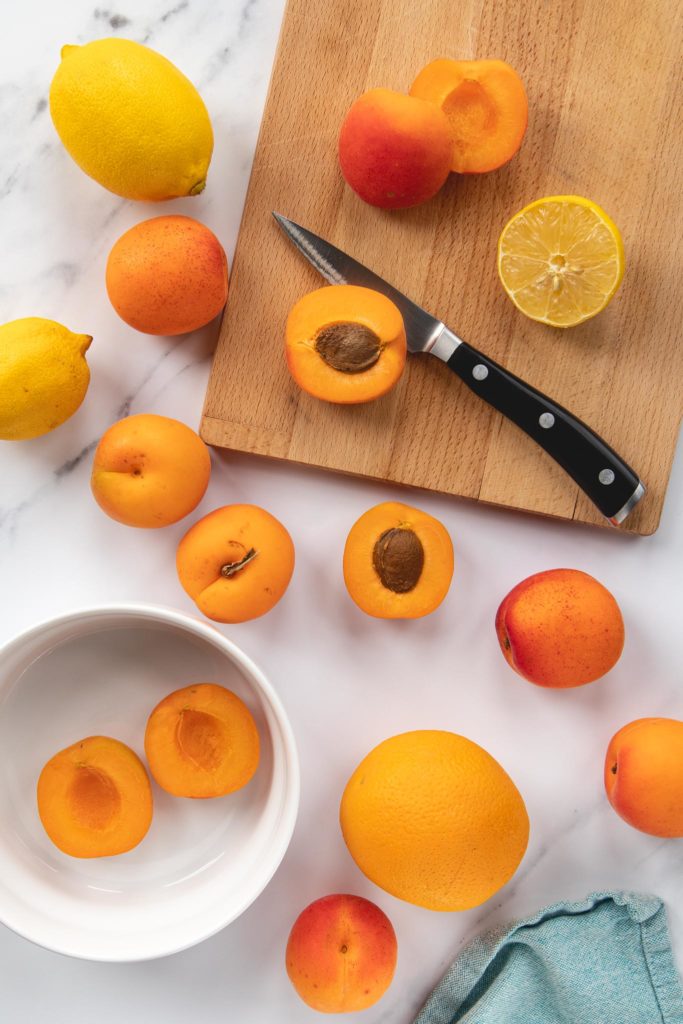
Apricot Jam
The jam makes slightly more than you need for the crostata. You won’t regret having extra. The jam can be kept for several days in the fridge, or freeze it.
Macerate the apricots:
Place the halved apricots and 250g (1 1/4 cups) sugar in a bowl and mix together. Cover the bowl and refrigerate for 1 hour.
Boil the macerated apricots:
Bring the macerated apricots to boil in a small saucepan over medium heat while stirring with a rubber spatula.
Refrigerate overnight:
Pour the mixture back into the bowl and cover. Allow it to cool, then refrigerate overnight.
Make the jam:
The next day, pour the mixture into a small saucepan and bring it to a boil over medium heat while stirring with a spatula.
Add the remaining 250g (1 1/4 cups) sugar and 2 1/2 tablespoons lemon juice.
Boil until thickened, about 10-20 minutes. While the jam boils, use a potato masher to mash the apricots and use a spoon to skim off the foam that rises to the surface.
To test if the jam has set, spoon a small amount of jam onto a cold plate. Let it sit for 10 seconds and then tilt the plate. If it’s still runny, it needs to cook longer. You can also use a thermometer. When the jam has thickened, it should be about 104°C (220°F).
Once it has thickened, pour the jam into a heatproof container and cover. Let cool to room temperature, and then place in the refrigerator until ready to use. It will set more after cooling in the fridge, so it might be best to make a day in advance.
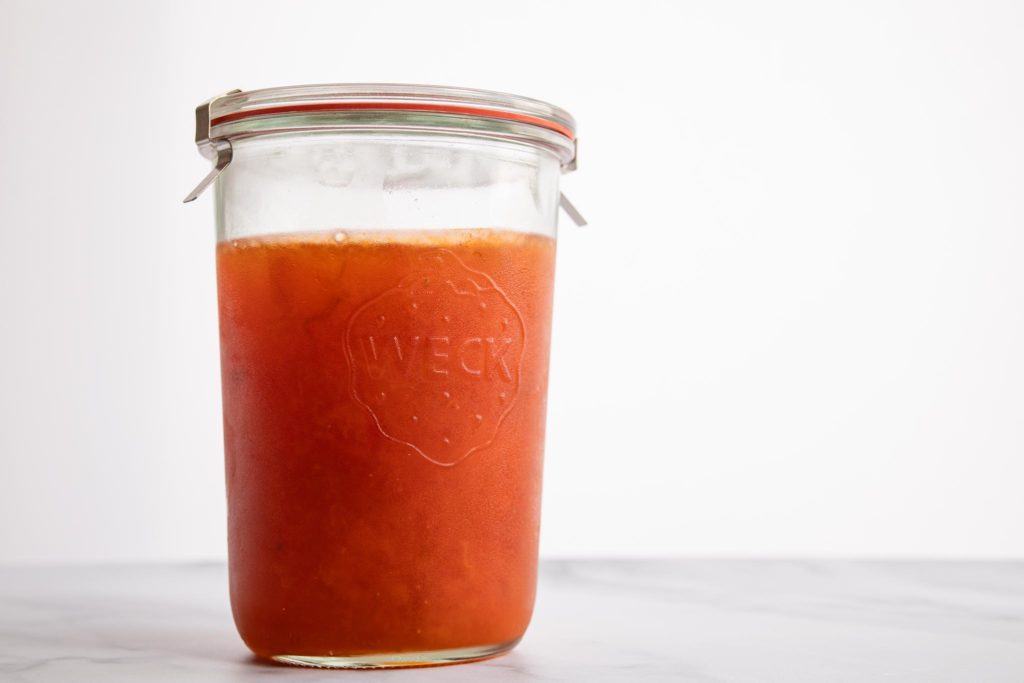
Pasta Frolla
Sift together the dry ingredients:
In a large bowl, whisk together the flour, sugar, zest and salt.
Cut in the cold butter:
Using a pastry blender, cut in the cubes of cold butter until the mixture is sandy and the largest pieces of butter are pea-sized.
Stir in the eggs:
Stir in the egg and egg yolks and mix until the dough comes together and forms a ball.
Chill and rest the dough:
Gather the ball of dough and flatten into a disc about 1 inch (2.5cm) thick. Wrap the dough in plastic and let it rest in the refrigerator for at least two hours, or overnight.
Assemble the Crostata
Preheat the oven:
Preheat the oven to 175°C (350°F).
Roll out the dough:
Try to work quickly to prevent the dough from warming up. Warm dough will stick to your work surface, making it hard to work with.
Unwrap the dough, dust it with flour and place it on a lightly floured surface.
Divide the dough into two pieces: 2/3 of the dough for one piece and the remaining 1/3 for the other.
Using a rolling pin, roll the larger piece dough into a circle, making sure it is slightly larger than the tart pan so there is enough dough to go up the sides.
Line the tart pan:
Carefully transfer the dough into the tart pan. Gently press the dough into place without stretching the dough or the sides will shrink while it bakes. Use a sharp paring knife to trim the edges.
Fill with jam:
Fill the tart with about 2 cups (about 600g) of jam and spread evenly. You don’t have to be precise here (people who know me will be shocked I wrote that). Fill with as much jam as you want, anywhere from 1 1/2 to 2 1/2 cups.

Prepare the lattice top:
Roll out the remaining piece of dough to just larger than the tart pan. Using a pastry wheel, pizza cutter, or long sharp knife, slice several thin strips of dough, about 1.5-2cm wide.
Lay half of the dough strips vertically across the tart. Rotate the pan 30° and lay the rest of the strips on top.
Trim the edges:
To trim the edges, use a rolling pin across the edges of the tart to press the dough into the side of the pan, neatly cutting off the extra and sealing the lattice onto the bottom layer.
Bake the crostata:
Bake the crostata for 25-30 minutes at 175°C (350°F), until the crust turns light golden brown and the jam starts to bubble.
Let the crostata cool to room temperature before serving.
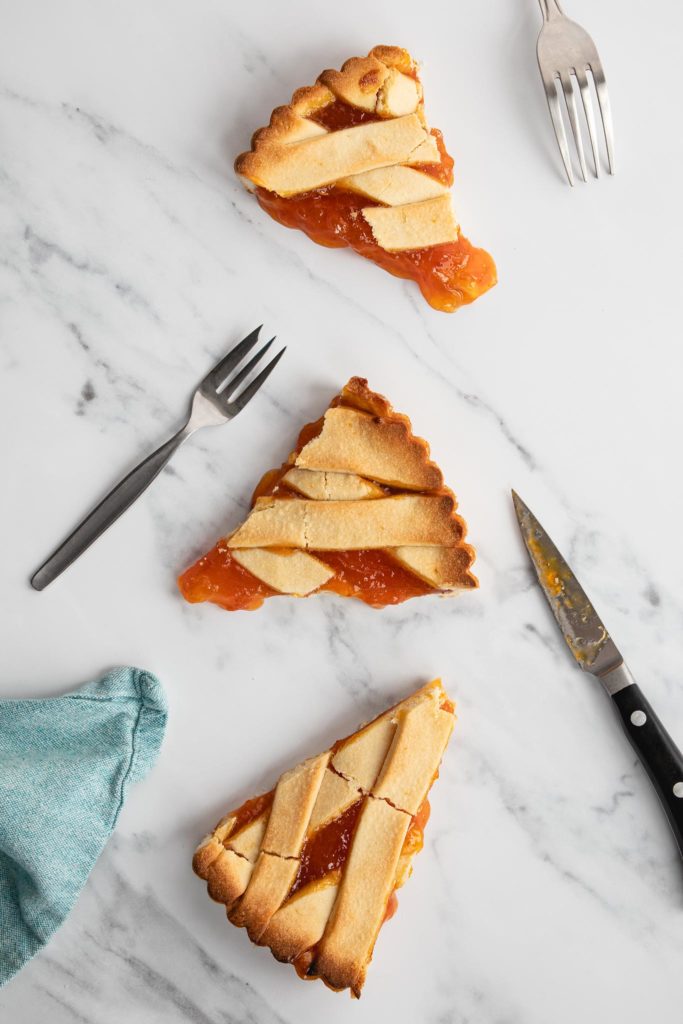

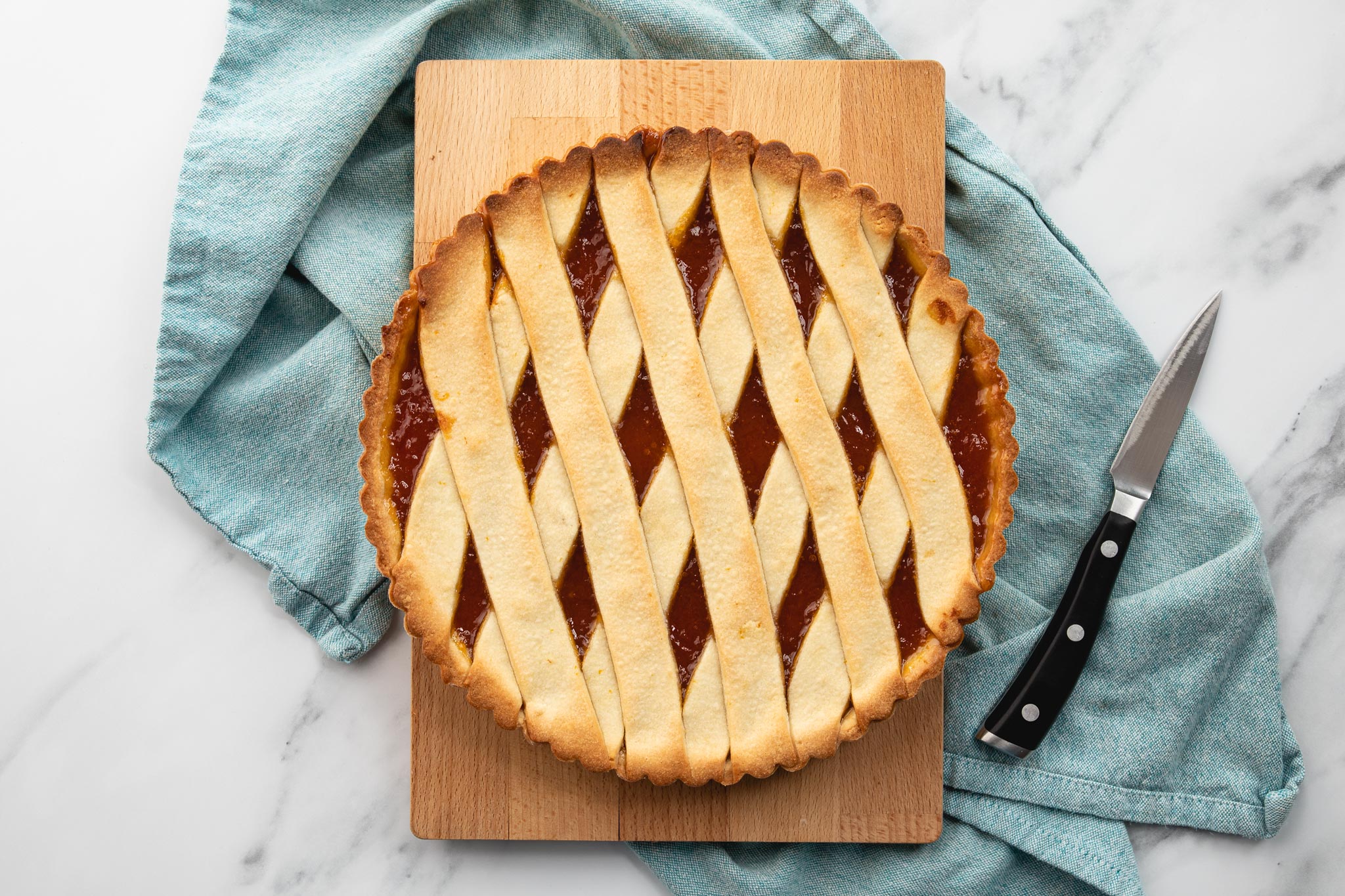
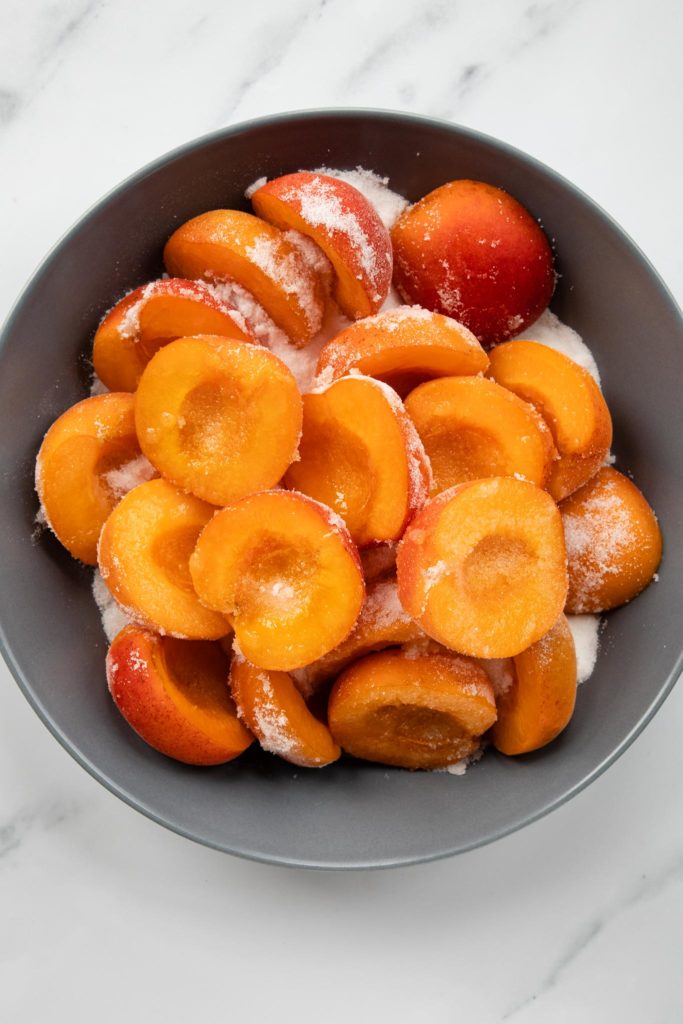
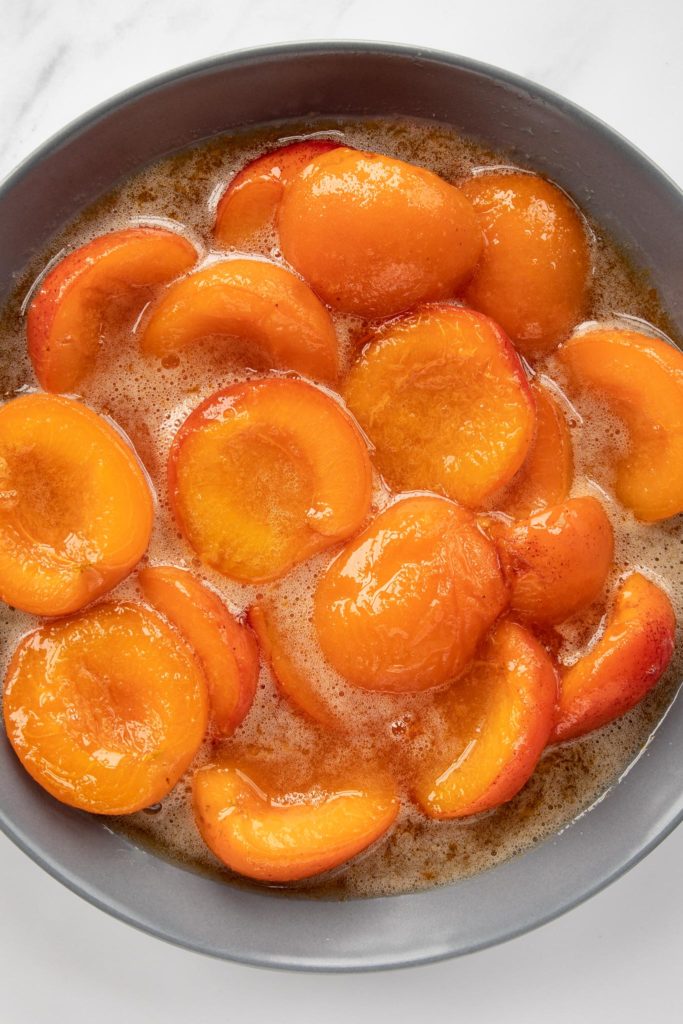
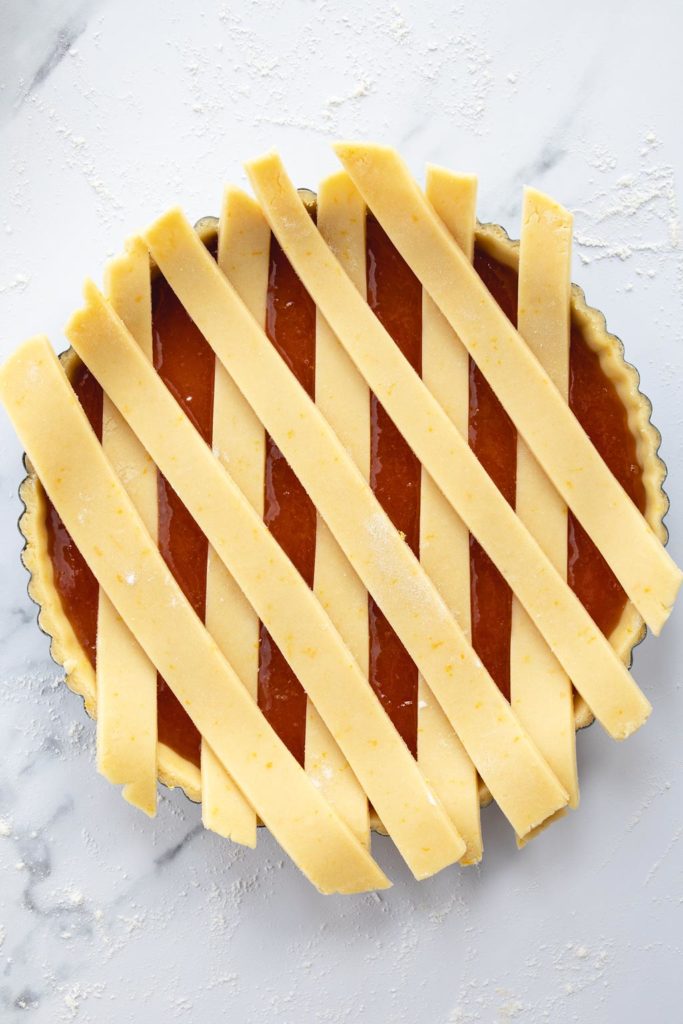
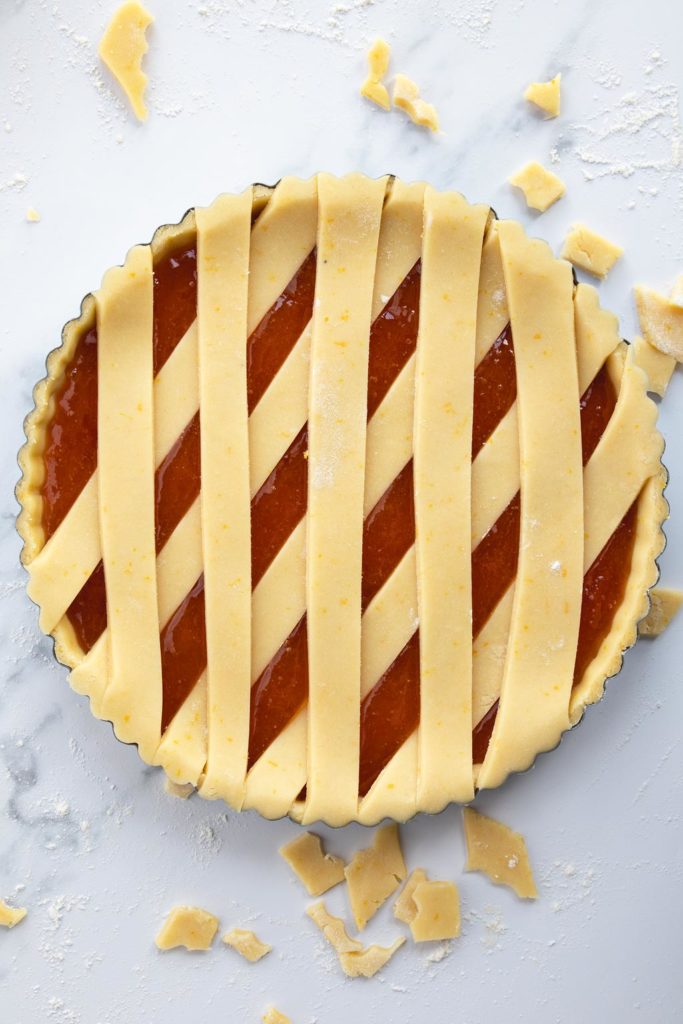
No Comments